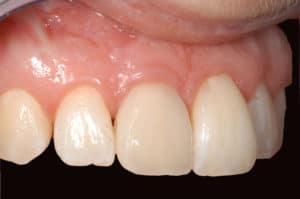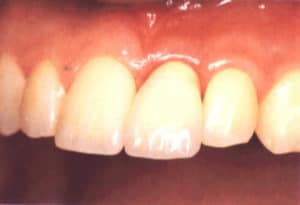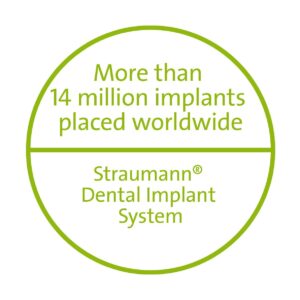What is a dental implant?

Dental implants are undoubtedly the closest substitute for your natural teeth. Just like a tooth, a dental implant consists of two parts: a root which lives beneath the gum line and visible tooth which shows above. While a natural tooth is made from enamel, a dental implant consists of a titanium base buried beneath the gum, and a porcelain crown above the gum matched to the colour of your natural teeth.
The titanium implants we use at Portobello Dental Clinic are fabricated by Straumann, the world’s biggest implant company, who pioneered the technology in the early 1980s. Titanium is extremely strong, resistant to corrosion and well-tolerated by the body.
When a dental implant is placed in the jaw, the bone and gum will heal around it in a process that lasts between three to six months.
Once integration occurs, it is time to attach the porcelain crown on top of the implant. The abutment (connector) can be made from titanium (as pictured) or from zirconium, which is tooth-coloured.
When should I get a dental implant?
 Consider speaking to your dentist about getting a dental implant if you have:
Consider speaking to your dentist about getting a dental implant if you have:
- A single tooth missing at either the front or back of your mouth
- Multiple missing teeth
- Dentures which do not sit comfortably and securely
Single missing teeth will only require an implant crown, whereas many missing teeth will need an implant bridge. It is not always necessary to create an implant for each missing tooth, as (for instance) three porcelain teeth can be attached to two implants.
Implants can also improve the fit of complete dentures. By sitting under a set of attached dentures, implants provide greater stability, comfort and improved chewing ability.
Less common uses of implants include:
- Placing implants under partial dentures to improve the fit and remove the need for unattractive clasps
- Using temporary implants as an anchor point for orthodontic treatment to straighten teeth
What are the benefits of dental implants?
- Dental implants have a very high success rate with 92% of implants still functioning perfectly after 10 years
- Implants preserve the natural state of your other teeth, as there is no need to remove layers from adjacent teeth for treatment
- They feel just like your own teeth
- Dental implants never decay
- They enable proper chewing and restore the full strength of your bite
- Implants prevent further bone loss once fitted
- They look great cosmetically
- They provide a permanent solution for missing teeth
- Titanium is a compatible material which naturally bonds with the jaw

Steps involved in getting Dental Implants
The first step in the dental implant process is the development of an individualised treatment plan. This plan is prepared by collaborative consultation with practice dentists, and through careful listening of your needs, followed by analysis of models of your teeth, x-rays, and CT scans where appropriate.
For most patients, the placement of dental implants involves two dental procedures. First, the titanium implant (replacement tooth root) is placed into the bone socket of the missing tooth. This procedure is carried out under sterile conditions under local anesthetic. Although it is entirely painless, some patients elect to be sedated during this phase for extra comfort.
During the procedure, we may also perform a bone graft, which is sometimes necessary to supplement the bone in the jaw so that the implant can be anchored firmly. This bone comes in granular form and is packed around the implant during its placement.
Immediately after this surgery, patients are given pain-relieving and anti-inflammatory drugs, for the following few days. Although dental implants have a very high success rate and infections after placement are rare, antibiotics are also prescribed at this stage to even further reduce the risk of infection.
For the next three to six months following surgery, the implant beneath the gum gradually bonds (integrates) with the jawbone.
The second stage begins after the implant has integrated with the bone. A healing cap is placed on top of the implant, after which impressions are taken and sent to a specialist implant laboratory. Finally, a connector post (known as the abutment) is attached to the implant and your custom-made porcelain tooth is fitted over the abutment. When completed, everything looks and feel just like a natural tooth.
What People Are Saying
It must be the best dental clinic in the country.
It’s at least the best I’ve ever visited. Got a Crown done, it was made in the clinic they use the most advanced technology I’ve ever seen.
From 3D scanners and programs to a mill that just makes the tooth in like 10 minutes. The staff are extremely friendly and ready to help answer any questions that you might have.
Honestly I’d give more stars but they only let me do 5.
I felt really looked after in all my dealings with this clinic, they’ve really gone above and beyond to provide the best care and clearest information. I especially appreciated the way Anne-Marie, the treatment co-ordinator, guided me through the process.
I would recommend the Portobello Dental Clinic because I felt the price was reasonable, the service was excellent, all the staff were incredibly friendly and helpful and the end result looked great.
I am so glad I found the Portobello Dental Clinic and have no hesitation in recommending them to my family and friends. Everyone at the Portobello clinic is professional and friendly and the follow up phone call after treatment, to inquire how I was feeling was much appreciated.
I recently got implants at Portobello. I am very satisfied with the results and I have confidence that if any problems do arise, that they will be dealt with. I have been going to Portobello for about nine years.
Considering dental implants? For a free consultation with a treatment coordinator at our Dublin dental clinic, call now on 01 454 2022
